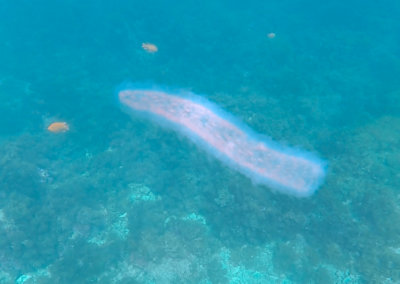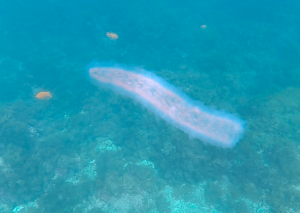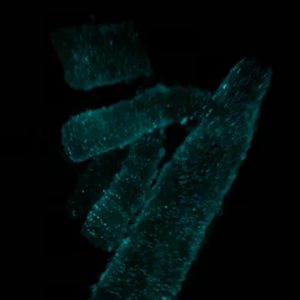
So this is a pyrosome? Cool, what does that mean?!?
 Pyrosomes are colonial organisms made up of hundreds to thousands of individual tunicates called Zooids! Our pyrosome friends may appear like a strange species of jellyfish however they are more closely related to us! This is because they posses a spinal cord and are taxonomically grouped with the Chordata Phylum. Scientist use this method called taxonomy to group and organize all organisms on earth based on similar characteristics. To be part of the Chordata phylum the shared characteristic required is a notochord, like a back bone. This is what separates Pyrosomes from the Jellyfish which classified as an invertebrate meaning an organism without a backbone!
Pyrosomes are colonial organisms made up of hundreds to thousands of individual tunicates called Zooids! Our pyrosome friends may appear like a strange species of jellyfish however they are more closely related to us! This is because they posses a spinal cord and are taxonomically grouped with the Chordata Phylum. Scientist use this method called taxonomy to group and organize all organisms on earth based on similar characteristics. To be part of the Chordata phylum the shared characteristic required is a notochord, like a back bone. This is what separates Pyrosomes from the Jellyfish which classified as an invertebrate meaning an organism without a backbone!
The Taxonomy break down looks like this:
Kingdom: Animalia
Phylum: Chordata
Subphylum: tunicate
Class: Thaliacea
Now that we are starting to wrap our minds around what a pyrosome is, what is it doing out in the ocean?
Pyrosomes are free-floating colonies of zooids in the pelagic open ocean where they filter feed on microscopic plankton. The colonies of zooids are connected by tissue communicate and coordinate behavior such as propelling the colony through the water. Each individual zooid pulls water from the outside to its microscopic plankton filtration station, once that water is filtered the zooid expels the water into the inside of the cylinder body. The volume of water being filtered by each individual zooid gives the colony propulsion mobility. Pyrosome colonies can range in size from a few centimeters and up to 60 feet long! The giant pyrosome can grow large enough a human can swim though the internal cavity! The zooids grow though the process of asexual reproduction to make new identical zooids that enlarges the colony. Sexual reproduction is used to create a new colony.
How can pyrosomes affect our oceans?
Pyrosome populations can explode into what scientist call a “bloom” with hundreds to thousands of colonies. A bloom of pyrosomes may have a big impact on the benthic food webs. When the pyrosome dies, its gelatinous body sinks rapidly to the oceans bottom creating a pyrosome buffet for all the bottom dwelling critters!
Why are pyrosomes so fascinating?!?

Pyrosomes are a somewhat rare occurrence on Catalina Island but when they arrive they have our full attention here at CIMI. What makes them so fascinating is their ability to produce bioluminescent light! Together the colonies of zooids communicate and when one zooid emits light, they all do! They can produce enough light to see from many yards away as they are washing up on the beach or propelling themselves through the water column.

Photo Credit: Heather Peterson
Sources:
https://owlcation.com/stem/Pyrosomes-Mysterious-and-Bioluminescent-Marine-Animals
https://esajournals.onlinelibrary.wiley.com/doi/full/10.1002/ecy.2097


